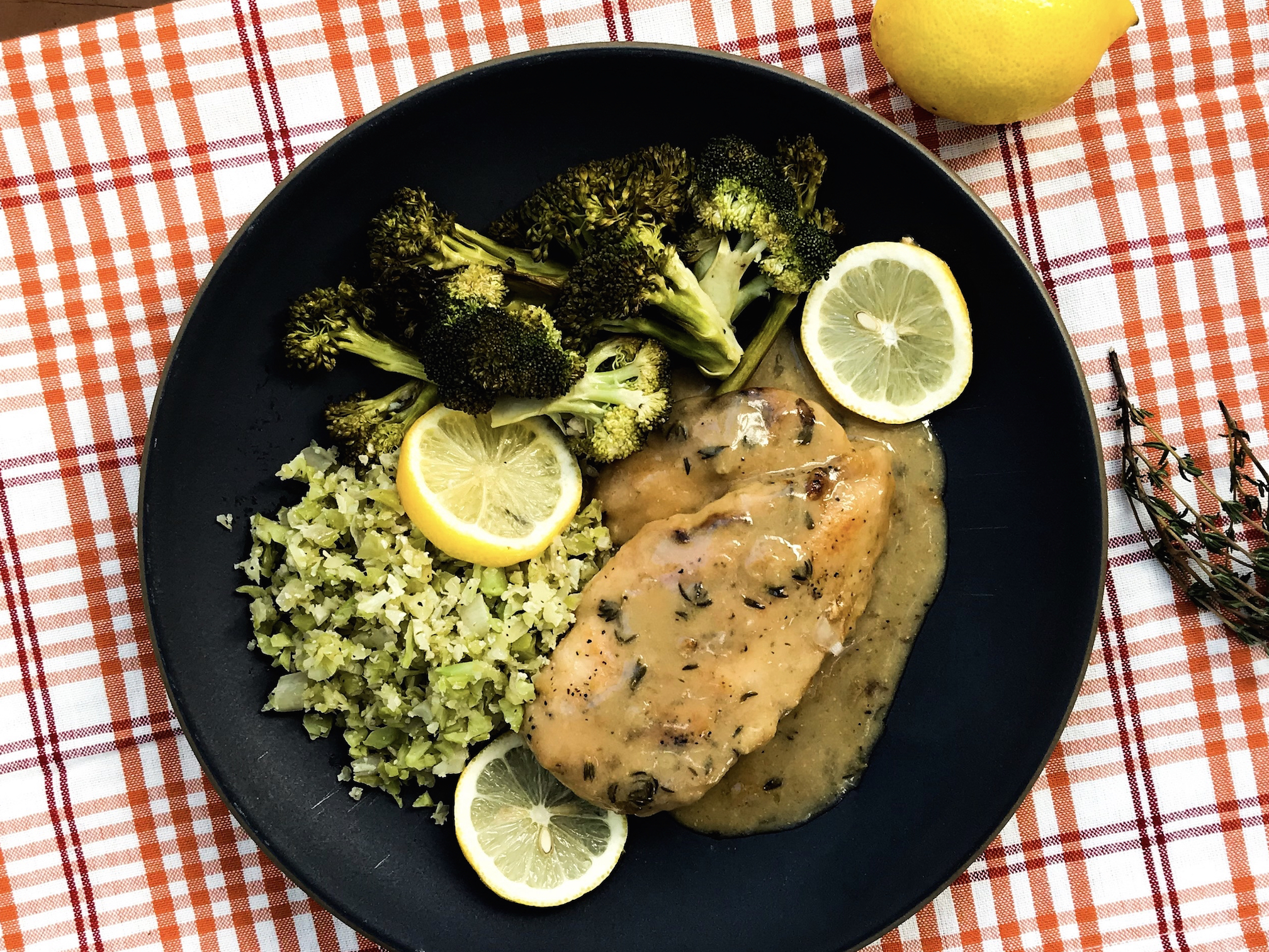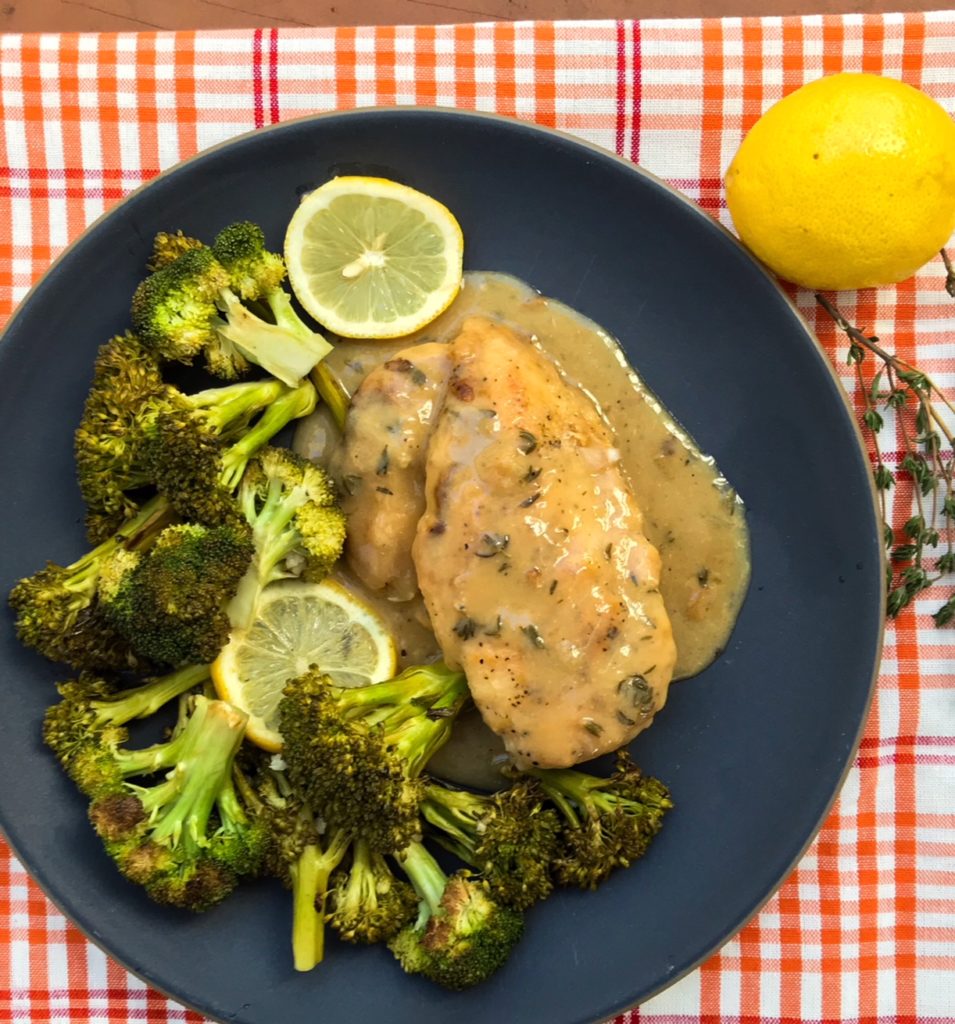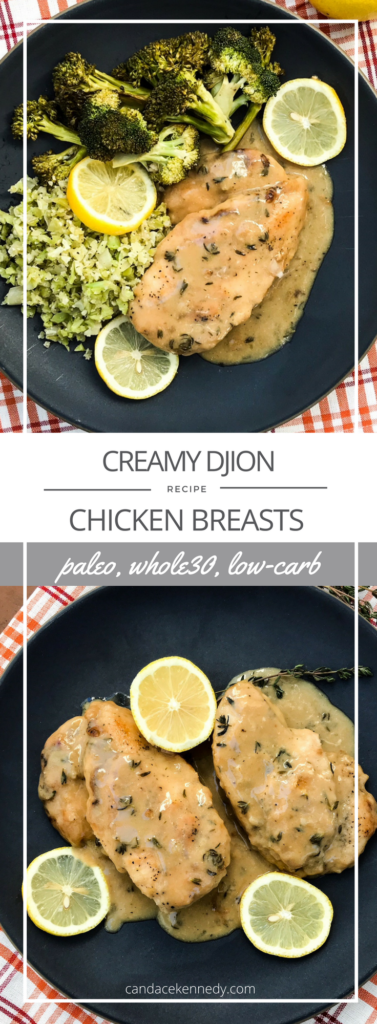Hiya! I hope your week is going fantastic and full of healthy, delicious, home-cooked meals. I get that it’s not always easy and there’s not always time to prepare something from scratch. Especially something “healthy”. That’s what I’m here for. I want to help make your week easier by giving you some simple, easy healthy recipes that are delicious and full of nutrients, like this Creamy Dijon Chicken.
You may be thinking, “yeah, yeah, another chicken dish.” But this recipe is so much more. It is so creamy and savory and satisfying, and it’s also pretty simple to throw together. You just need one skillet and fewer than 30 minutes. While the chicken is simmering on the stove, you can throw some vegetables in the oven or steamer, and have a super healthy meal in no time. This chicken is delicious with cauliflower mash, steamed broccoli, or roasted kohlrabi.
What are the health benefits of this Creamy Dijon Chicken?
Glad you asked! Most people associate chicken with just being a good source of protein. It is, but it’s also so much more.
Here are some of the nutrients that chicken has to offer:
- Selenium: a nutrient needed for healthy thyroid function and a healthy metabolism.
- Niacin: a b-vitamin needed for energy production and cardiovascular health. Studies show niacin can also reduce the rate of cognitive decline.[1]
- Phosphorus: Phosphorus is an important mineral for healthy teeth and bones. It can also help boost your energy levels through its role in energy production (in the form of ATP).
Other recipe benefits:
The other ingredients in this recipe for Creamy Dijon Chicken have some stand-out health benefits too!
- Apple cider vinegar can improve insulin sensitivity, promote weight loss, and it has natural anti-bacterial and anti-fungal properties.
- Grass-fed butter is a great source of CLA, vitamin A, and butyrate (a fatty acid that promotes gut health).
- Bone broth is an excellent source of glycine, an amino acid that can reduce inflammation and promote cell health. (it’s also a great source of collagen!)
But let’s get back to chicken, cause that’s at the heart of this dish. Like all foods, quality matters. Let’s talk about that.
How to choose the right chicken:
If I had to pick one animal source of protein and say “it is especially important that you buy the right kind,” chicken is that meat. If you don’t have access to humanely, pasture-raised or organic chicken, I’d say just skip it. That goes for ordering chicken at restaurants, too. I get that’s a strong stance, but here’s why:
- Of all the animals raised for consumption, chickens are treated the worst. Laws protecting animal welfare, including humane slaughter laws, often don’t extend to chickens. Conventionally-raised chickens live in filthy conditions and eat highly inflammatory diets. They “rest” in piles of manure and breathe in air that’s full of ammonia.
- Modern breeding practices of conventional chickens have created such a Franken-animal that, if they are not killed by the age of 5 weeks, they will likely die of organ failure.
- Pasture-raised chicken has more vitamin E and omega-3 fatty acids and fewer inflammatory omega-6 fatty acids than conventionally-raised chicken, suggesting an increase in health benefits, including cardiovascular health.[2]
Don’t be fooled by these marketing labels:
- Vegetarian-fed: Chickens are not vegetarians. They eat small bugs, worms, and even mice. Chickens are not meant to eat loads of pesticide-sprayed, GMO corn and soy (just like you aren’t either). Vegetarian-fed is at least better though than chickens eating animal by-products, I’ll give you that much.
- All-natural: This is a huge joke. It basically means no artificial colors, flavors, or other artificial ingredients. Although they can still be pumped full of antibiotics and fed GMOs. That doesn’t seem so natural to me.
- Hormone-free: It’s illegal to give hormones to chickens in the US. So if you see this label, it’s simply a marketing gimmick.
- Free-range, Roaming, and Cage-free: Sadly, these labels don’t mean much either. It sounds great, but this could still mean that the chickens are in despicable conditions, eat inflammatory diets, and have minimal exposure to the outside. Chickens can live in a huge factory, with no windows or fresh air, and still be cage-free.
Look for these labels instead:
- Pasture-raised: This is the label I always look for, although these birds can be difficult to find. Pasture-raised means that the birds have had regular access to the outdoors and eat a much more natural diet that includes grass and bugs. Their diet is often supplemented with grains including oats, soy, and corn, but you can find pasture-raised chickens that eat pesticide-free and non-GMO grains. Some farmers even raise their own organic grains to feed their chickens. If you have direct access to your farmer, ask them about what they feed their chickens and how they are raised.
- Organic/Beyond Organic: If you absolutely cannot find pasture-raised chicken, this would be your next best bet. At the very least, USDA certified chickens are raised without antibiotics, eat a non-GMO, organic diet, and have access to the outdoors and pasture (even if it’s just a short amount of time). They may still eat a vegetarian diet, but it’s better than the GMO corn and soy that CAFO chickens eat. You may sometimes see the label “beyond organic” and this is legit. Getting organic certification is a really expensive, long process for small family farms. Although they are not USDA certified organic, their farming practices meet or exceed organic certification requirements. Ask around at your farmers market to find out who raises the healthiest chickens in a humane, sustainable manner.
Yes, pasture-raised > organic:
Just to harp on this a little bit more, a recent study showed that while both pasture-raised chickens and organic chickens have higher omega-3 content than conventionally-raised, only the pasture-raised chicken showed an increase in the total amount of antioxidants in the meat. The pasture-raised chicken meat was also less likely to experience fat oxidation (probably because of the increased amount of antioxidants.[3]
So, to sum this section up, look for pasture-raised chickens. If those aren’t available, organic/beyond organic is a good choice too. All the other labels don’t mean much.
How to find pasture-raised chicken (or organic/beyond organic chicken):
- If you live in the Bay Area, Belcampo and Prather Ranch both carry delicious, pasture-raised, high-quality chicken. Prather doesn’t often carry chicken parts, but rather a whole roasting chicken.
- If you live outside the Bay Area, try to find a butcher that sources locally. Make sure to ask about how the chickens were raised and what they were fed to make sure you’re buying high-quality, sustainable chicken.
- If you don’t have access to local, pasture-raised chicken, don’t worry. US Wellness Meats carries some of the best quality chicken out there. They are also one of the few places that even carries soy-free chicken (especially important for people with severe soy allergies!) Plus, they ship directly to your door. Can’t get easier than that.
Now that you’ve found some delicious, nutrient-dense, sustainably-raised chicken, let’s start cooking.
Here’s what you need:
- 1.5 lbs chicken (I used chicken breasts, but thighs would work too)
- Sea salt
- Black pepper
- 1/4 cup plus 1 T tapioca flour, divided
- 2 T grass-fed butter
- 1 cup chicken bone broth
- 1 T apple cider vinegar
- 1 T lemon juice
- 1/2 cup coconut cream*
- 1 T Dijon mustard
- 2 tsp. chopped fresh thyme
- 1/2 lemon, sliced
*To get the coconut cream, place the can of coconut milk in the fridge for several hours. The cream will separate from the milk. Carefully open the can and scoop the hardened cream out from the top. Save the rest of the coconut milk to use in other recipes or put in your coffee or tea.
Here’s what you do:
- Dry chicken breasts (or thighs) and season with salt and pepper. Toss the chicken with the 1/4 cup tapioca flour until they are evenly covered.
- Heat the butter in a large skillet to medium heat. Once the pan is good and hot, add the chicken thighs and cook until browned, flipping once to brown both side.
- While the chicken is cooking, combine the chicken broth, coconut cream, lemon juice, apple cider vinegar, mustard, and thyme. While whisking the dijon sauce, slowly add the 1 T of tapioca flour. Keep whisking until everything is well-combined.
- Pour the mixture over the chicken and scrape the pan for any browned bits left behind. Partially cover the skillet and continue cooking until the chicken is cooked through, about 10-12 minutes.
- Serve with sliced lemons and the dijon sauce on top or on the side.
Pin and save for later:
Printer-friendly recipe card:


- 1.5 lbs chicken (I used chicken breasts, but thighs would work too)
- Sea salt
- Black pepper
- 1/4 cup plus 1 T tapioca flour, divided
- 2 T grass-fed butter
- 1 cup chicken bone broth
- 1 T apple cider vinegar
- 1 T lemon juice
- 1/2 cup coconut cream*
- 1 T Dijon mustard
- 2 tsp. chopped fresh thyme
- 1/2 lemon, sliced
- Dry chicken breasts (or thighs) and season with salt and pepper. Toss the chicken with the 1/4 cup tapioca flour until they are evenly covered.
- Heat the butter in a large skillet to medium heat. Once the pan is good and hot, add the chicken thighs and cook until browned, flipping once to brown both side.
- While the chicken is cooking, combine the chicken broth, coconut cream, lemon juice, apple cider vinegar, mustard, and thyme. While whisking the dijon sauce, slowly add the 1 T of tapioca flour. Keep whisking until everything is well-combined.
- Pour the mixture over the chicken and scrape the pan for any browned bits left behind. Partially cover the skillet and continue cooking until the chicken is cooked through, about 10-12 minutes.
- Serve with sliced lemons and the dijon sauce on top or on the side.
- *To get the coconut cream, place the can of coconut milk in the fridge for several hours. the cream will separate from the milk. Carefully open the can and scoop the hardened cream out from the top. Save the rest of the coconut milk to use in other recipes or put in your coffee or tea.
important notes:
I am not a doctor, and I don’t claim to be one. I can’t prevent, treat, cure or diagnose illness or disease. The information presented on this website is not meant to replace a one-on-one relationship with your health care professional and is not intended as medical advice, treatment or diagnosis. The purpose of this website is to share knowledge from my research and experience. I encourage you to make your own decisions regarding your health care based on your own research and relationship with your healthcare professional.
I make a small commission from the product links above, although the price of the products stays the same for you, whether or not you purchase through my affiliate links. You can purchase these products directly from the sites if you don’t wish to use my affiliate links.
References:
[1] https://www.ncbi.nlm.nih.gov/pubmed/15258207
[2] https://www.ncbi.nlm.nih.gov/pubmed/26769274
[3] https://www.ncbi.nlm.nih.gov/pubmed/26769274




